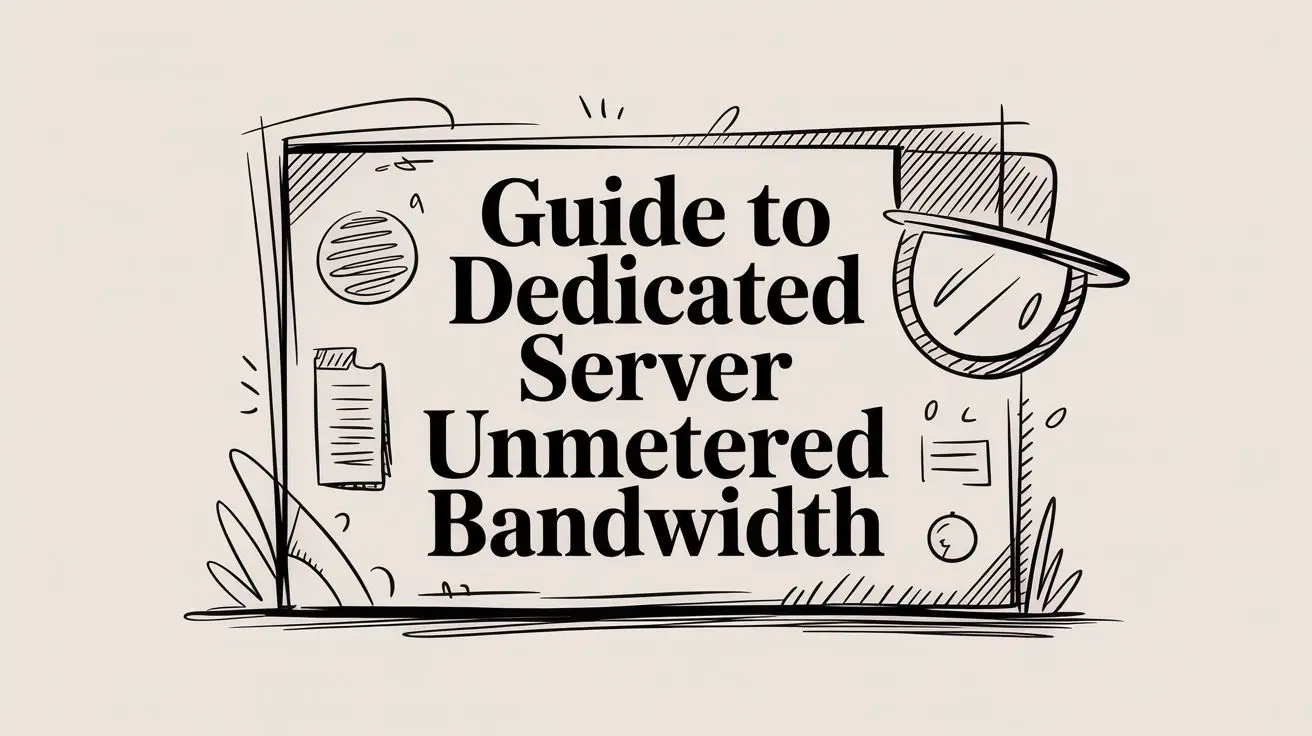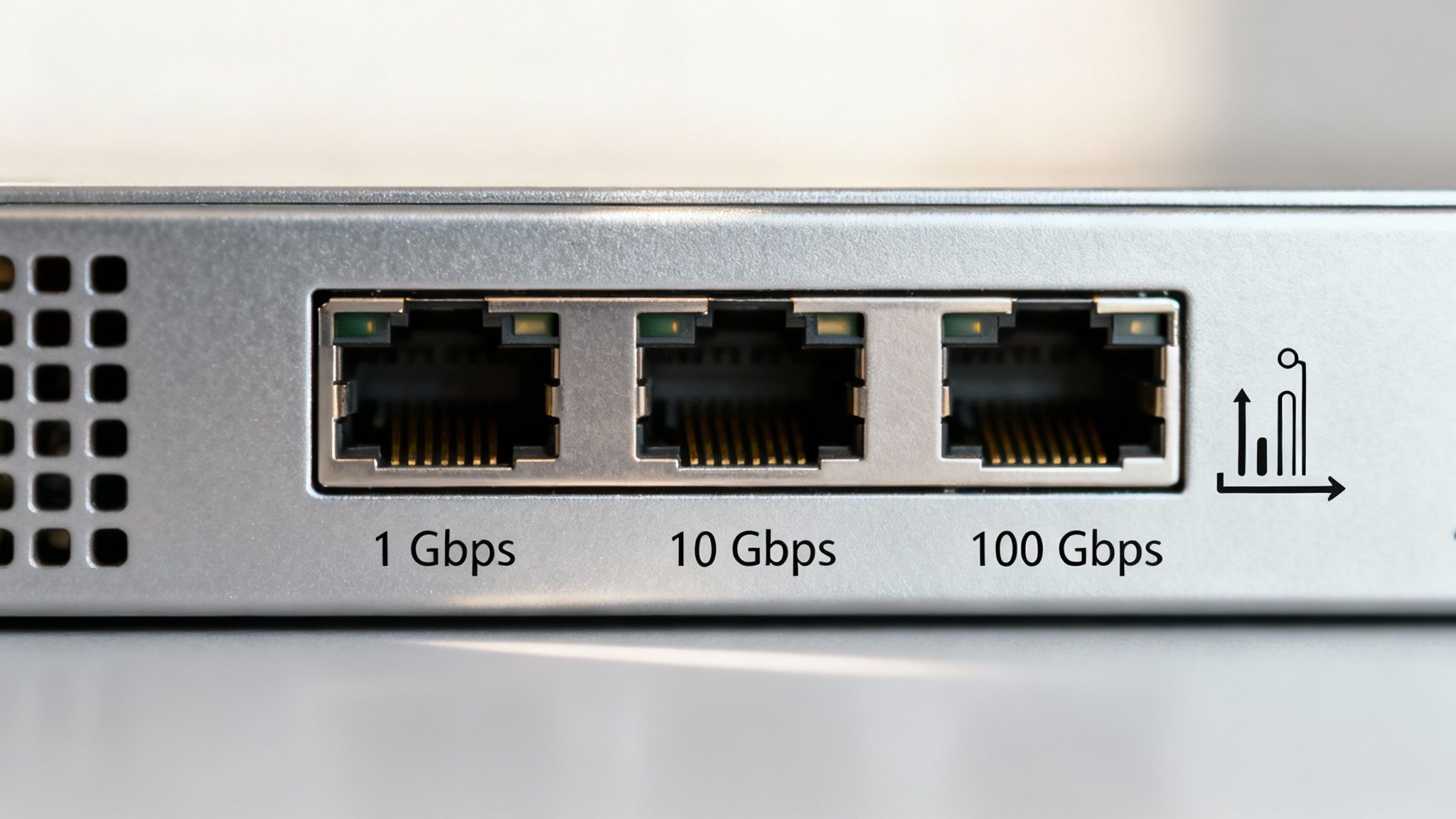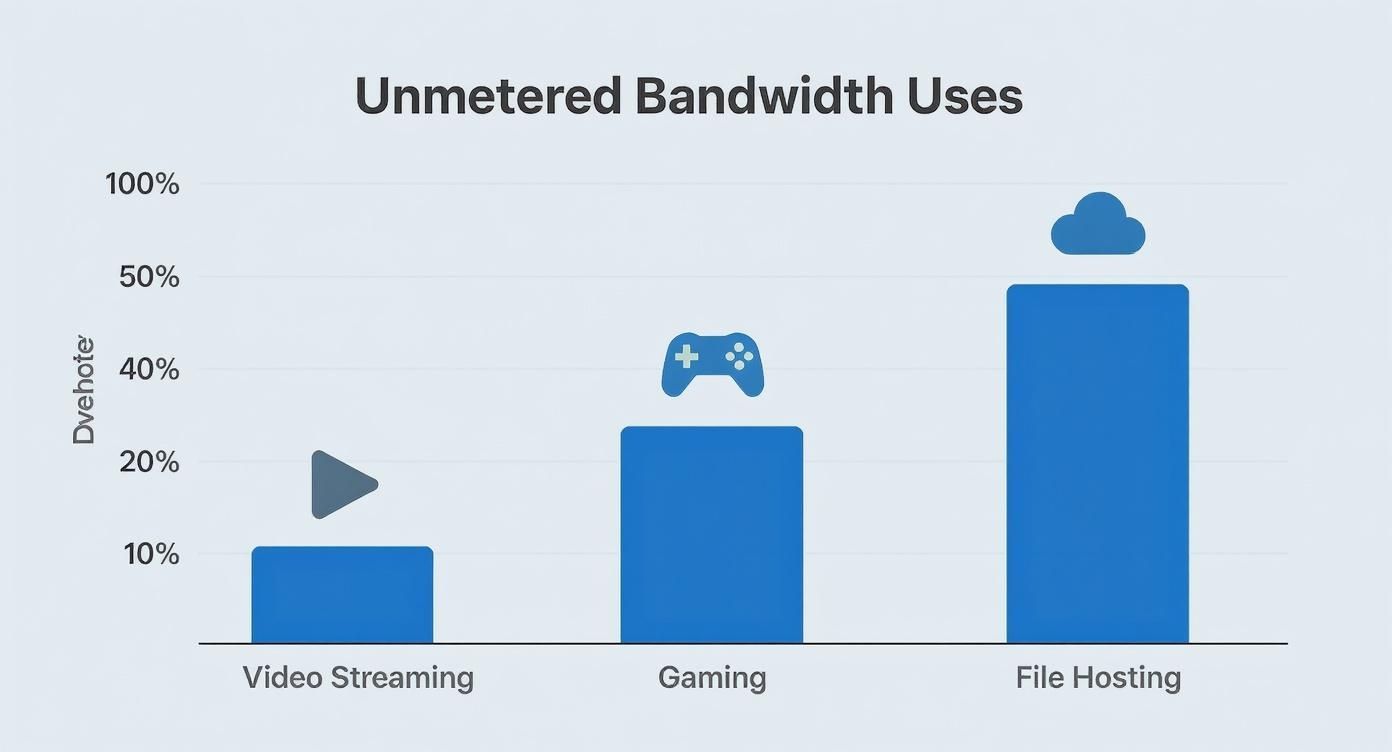
If you're in the market for a dedicated server, you’ve probably seen the term "unmetered bandwidth" tossed around. It sounds great, but what does it actually mean for your business? In short, it’s all about predictable costs. You can transfer as much data as you need without ever worrying about surprise overage fees.
But let's be clear: "unmetered" isn't the same as "infinite speed." It's about unlimited data transfer—up to the hard limit of your server's network connection, also known as its port speed.
What Unmetered Bandwidth Really Means

When you're looking at hosting plans, the words "unmetered" and "unlimited" can be confusing, but they describe totally different things. The real win with unmetered bandwidth is financial stability. Your bill stays exactly the same, no matter how much data your website or app pushes out.
Think of your server’s connection as a highway. The port speed—let's say it's a 1 Gbps or 10 Gbps connection—is the highway itself. It has a fixed speed limit. Unmetered bandwidth means you can send a constant stream of cars (your data) down that highway, 24/7, without ever paying an extra toll. The only thing holding you back is how many cars can physically fit on that highway at any given moment. That’s your port speed.
This kind of setup is a lifesaver for businesses with unpredictable traffic spikes or consistently high data usage. You can serve huge files, stream video, or run a popular SaaS application without nervously checking a usage meter to avoid a massive bill at the end of the month.
The Two Pieces of the Puzzle
To really get it, you just need to understand the two key factors at play:
- Port Speed: This is the maximum speed data can travel to and from your server. It's measured in gigabits per second (Gbps) and acts as your connection's "speed limit."
- Data Transfer: This is the total volume of data you move over a set period, usually a month. It’s measured in terabytes (TB).
With an unmetered plan, you pick a port speed and you're free to use as much data as that connection can handle. No hidden charges. No overage fees. If you want to dive deeper into how this all works, check out the fundamentals of dedicated servers and how they're configured.
The biggest advantage of a dedicated server with unmetered bandwidth is cost certainty. Your monthly hosting bill is fixed, making it easy to budget, even if your traffic goes through the roof.
To make things even clearer, let's break down how the three main bandwidth models stack up against each other.
Bandwidth Models At a Glance
Choosing the right bandwidth model really comes down to what your application needs. Are you prioritizing performance, predictable costs, or just getting started? This table cuts through the noise and lays out the key differences.
| Bandwidth Model | Data Transfer Limit | Port Speed | Best For |
|---|---|---|---|
| Metered | Capped (e.g., 20 TB/month) | Fixed (e.g., 1 Gbps) | Websites with low or highly predictable traffic. |
| Unmetered | None | Fixed (e.g., 10 Gbps) | High-traffic sites, streaming, gaming, SaaS. |
| Unlimited | None | Variable (Often shared) | Small personal sites or blogs on shared hosting. |
As you can see, each model serves a different purpose. For businesses that can't afford downtime or surprise bills, the stability of an unmetered plan is tough to beat.
Why Unmetered Connections Boost Performance
Sure, predictable costs are a huge plus, but the real magic of a dedicated server unmetered bandwidth plan is its raw, unthrottled performance. Think of it as having your own private express lane on the internet versus sharing a public highway that could gridlock at any moment. Your applications get the full, sustained power of their connection, period. No artificial data caps, no surprise slowdowns.
This becomes absolutely critical during unexpected traffic surges. Let’s say your big promotional campaign suddenly goes viral, or you drop a new game patch that everyone wants right now. On a metered plan, that very success could get you throttled or even shut down to prevent overage fees. An unmetered connection just handles it, maintaining a high-quality user experience precisely when it matters most.
For IT teams, this is a game-changer for capacity planning. Instead of babysitting a data meter and worrying about monthly allowances, they can focus their energy on optimizing the application itself. The server’s port speed is the only metric that matters, simplifying how you manage infrastructure and completely removing the fear of performance hits.
Sustaining Mission-Critical Operations
In some industries, uptime and responsiveness are everything. There's simply no room for the slightest interruption or lag caused by hitting some arbitrary data transfer limit. In these fields, unmetered bandwidth isn't a luxury; it's the standard.
- Video Streaming and Media: Platforms pushing high-definition content need a massive, continuous firehose of data. Unmetered connections guarantee a buffer-free stream for every single viewer, whether you have one hundred or one hundred thousand.
- Online Gaming: For any multiplayer game server, low latency and a steady data flow are non-negotiable. Throttling introduces lag, and lag absolutely ruins the player experience.
- SaaS Applications: Software-as-a-Service platforms have to be on and responsive 24/7. An unmetered server ensures performance stays snappy for all clients, even as your user base explodes.
An unmetered dedicated server is basically performance insurance. It guarantees your resources are always there to meet demand, protecting both your user experience and your brand's reputation.
This need for reliability is more common than you might think. Recent data shows that 86% of IT professionals now rely on dedicated servers for their most important tasks, where consistent performance is a must. This trend has pushed providers to offer some seriously powerful connections, with 25 Gbps, 50 Gbps, and even 100 Gbps unmetered ports becoming available for the most data-hungry applications.
You can see a great breakdown of this growing demand for unmetered dedicated server options and how it's shaping modern business. And if you're looking to squeeze every last drop of speed out of your setup, especially when dealing with high data volumes, check out these proven tips for faster systems.
How to Choose Your Unmetered Server Configuration

Picking the right dedicated server unmetered bandwidth plan goes way beyond just grabbing "unlimited" data. The real decision is about matching the server's core hardware to what you actually do. Two choices will define your experience more than any others: your port speed and whether you go with a managed or unmanaged server.
Get these right, and you're golden. Get them wrong, and you could end up paying for a superhighway you never use or, worse, creating a bottleneck that throttles your mission-critical apps.
Decoding Port Speed for Real-World Use
Think of your port speed as the number of lanes on your data highway. Unmetered bandwidth means the road never ends, but the port speed dictates how many cars can travel on it at the same time. This is what determines whether your users get a smooth, fast experience or a frustratingly slow one.
Here’s a quick gut check on what different speeds can realistically handle:
- 1 Gbps Port: This is the go-to starting point for a reason—it’s a workhorse. A 1 Gbps connection can juggle hundreds of simultaneous audio streams, dozens of 4K video streams, or a high-traffic e-commerce site during a holiday sale without breaking a sweat. It's a fantastic fit for most SaaS platforms, big online forums, and busy web applications.
- 10 Gbps Port: Now we're entering high-performance territory. A 10 Gbps line is built for serious data-slinging, like large-scale video streaming platforms, game servers hosting thousands of concurrent players, or CDN nodes pushing massive files across the globe.
- 100 Gbps Port: This is the big league. Reserved for enterprise-level demands, a 100 Gbps port is what powers global media broadcasters, the backbones of major cloud providers, and huge data processing operations.
Choosing your port speed is like deciding between a multi-lane road (1 Gbps) and a massive superhighway (10 Gbps). Both can handle a lot of traffic, but one is clearly built for a much higher volume and intensity.
Managed vs. Unmanaged: The Critical Support Decision
Once you've nailed down your speed, your next big decision is who will be in charge of the server. This really boils down to your team's technical know-how, available time, and budget. It's a classic trade-off between total control and total convenience.
An unmanaged server hands you the keys to the kingdom with full root access, but you're on the hook for everything—security, updates, troubleshooting, the works. It demands deep technical expertise. A common technical task on an unmanaged server is manually patching the kernel for a security vulnerability. This involves SSHing into the server, downloading the patch, compiling it, and rebooting—a process that requires confidence with the command line.
On the flip side, managed hosting means you have an expert team handling all the server administration for you. This is a lifesaver for businesses without a dedicated IT staff, but it naturally comes at a higher price. For a deeper dive into making this choice, check out our guide on the 5 key factors to consider when choosing a hosting provider. As the server market continues to grow, with dedicated servers at the core, getting this decision right has never been more important.
Unmetered Bandwidth in Action
It’s one thing to talk theory, but seeing a dedicated server unmetered bandwidth plan solve real-world problems is where the rubber meets the road. For some businesses, this isn't a perk—it's the only viable way to operate. These are companies built on pushing massive amounts of data without getting throttled or slapped with a surprise overage bill.
Let's look at a few places where this really clicks.
Powering Streaming and Online Gaming
Think about a video streaming service, whether it’s a public platform like Twitch or a private one used for corporate training. Every single viewer is pulling a constant, high-quality stream of data. With an unmetered connection, that service can support thousands of concurrent users, all getting a smooth, buffer-free experience. The only real ceiling becomes the server's port speed, not some arbitrary data cap.
Online gaming is another perfect example. In competitive multiplayer games, latency is the ultimate fun-killer. An unmetered dedicated server guarantees that the enormous flow of game-state data reaches every player consistently. This is what creates the low-latency, stable connection needed for fair and responsive gameplay, even with thousands of people logged in at once.
For businesses built on delivering real-time content, an unmetered server is the foundation of their user experience. It removes the risk of performance degradation, protecting both customer satisfaction and revenue.
Handling High-Traffic and Data-Heavy Applications
The value of unmetered bandwidth goes way beyond media and gaming. It’s an essential tool for any operation that expects high—or wildly unpredictable—data transfer.
Here are a few more common scenarios where an unmetered connection is non-negotiable:
- High-Traffic E-commerce: Picture an online store on Black Friday. Traffic can easily spike 10x or more in a few hours. An unmetered server just absorbs that surge, ensuring the site stays fast and responsive. No lost sales due to a crashed or slow-loading website.
- Large-Scale File Hosting: If you're a business that stores and distributes large files—like a software company pushing updates or a design firm sharing high-res assets—you live and die by your transfer capacity. Unmetered allows your customers and team to download huge files quickly without you ever worrying about hitting a monthly data limit.
- CDN Nodes: A Content Delivery Network (CDN) strategically places servers around the globe to cache content closer to users. These nodes are data firehoses, and they absolutely require unmetered connections to serve massive amounts of data to regional audiences, slashing website load times everywhere.
- Data-Intensive SaaS: A Software-as-a-Service (SaaS) application serving thousands of clients is in a state of constant data flow. Unmetered bandwidth ensures the application stays performant for every user as the business scales, without introducing unpredictable hosting costs that could wreck its financial model.
Comparing Costs of Metered vs Unmetered Hosting
When choosing a hosting plan, it often boils down to a simple trade-off: do you want a lower upfront cost or a predictable bill you can count on every single month? Metered plans look appealing at first glance, often dangling a lower price tag. But that initial savings can hide the very real danger of overage fees, which can vaporize any perceived benefit in an instant.
This is where a dedicated server unmetered bandwidth plan becomes a strategic business decision, not just a technical one. The financial stability it provides is invaluable for any business that deals with fluctuating traffic or high-demand applications. Think of the slightly higher base cost as insurance against your own success—it ensures your budget doesn't break the moment your traffic takes off.
The Hidden Danger of Overage Fees
Let's walk through a common scenario. Imagine a media website running on a dedicated server with a metered plan that includes what seems like a generous 10TB of monthly data transfer. Everything is fine until one of their articles goes viral, driving a tidal wave of new visitors to the site.
Or picture an e-commerce store launching a flash sale that's a massive hit. Traffic suddenly surges 500% above normal for a few days straight. In both cases, a metered plan would trigger expensive overage fees, turning a huge win for the business into a painful financial surprise.
You'll see this need for predictability across a few key industries that simply can't afford to guess their data usage from month to month.

As you can see, data-heavy operations like video streaming, gaming, and file hosting are prime candidates for unmetered connections. For them, cost certainty isn't a luxury; it's essential for survival.
So, let's put some real numbers to this and see how it all shakes out.
Cost Projection Metered vs Unmetered Bandwidth
The table below breaks down the total monthly cost for both types of plans under a few different traffic scenarios. For this example, we’ll assume the metered plan charges a standard $0.02 per GB for any data that goes over the included 10TB allowance.
| Scenario | Metered Plan (10TB Included) | Unmetered Plan (1 Gbps Port) |
|---|---|---|
| Normal Month (8TB Used) | $120.00 | $150.00 |
| Viral Spike (25TB Used) | $120 + (15,000 GB x $0.02) = $420.00 | $150.00 |
| Flash Sale (40TB Used) | $120 + (30,000 GB x $0.02) = $720.00 | $150.00 |
The numbers don't lie. While the metered plan is slightly cheaper during a slow month, its cost balloons the second you get a surge in traffic. Meanwhile, the unmetered plan’s cost stays locked in at $150.00, delivering significant savings and total peace of mind when it matters most.
This kind of predictability is the foundation of smart infrastructure planning. For any business that needs top-tier performance and stability without the budget anxiety, finding the best bare metal server provider is the next logical step. An unmetered bare metal server gives you the raw power you need with the cost certainty that lets you scale your operations with confidence.
Future-Proofing Your Infrastructure
Picking a hosting solution isn't just about what you need today. It's a strategic bet on your business's future. Think of a dedicated server with unmetered bandwidth less as a piece of hardware and more as the foundation for sustainable, long-term growth. It gives you the runway to expand without constantly checking your rearview mirror for unexpected costs.
As your user base grows, so do your data demands—it’s an inevitable part of success. Whether you're launching new services, processing more transactions, or serving up richer content, an unmetered connection means you can scale smoothly. You’re free to innovate without the fear of hitting a bandwidth ceiling or getting slapped with a bill that blows up your budget.
This model provides something incredibly valuable: peace of mind. It takes the guesswork out of capacity planning and frees up your technical team to focus on what actually moves the needle—building better products and services for your customers.
Scaling for Tomorrow's Demands
Investing in infrastructure that can handle tomorrow's success is one of the smartest moves you can make. The web hosting market is ballooning to meet this exact need. In 2023, the global web hosting market hit $124.80 billion, and it's projected to climb to $159.9 billion by 2025. This massive growth is driven by the relentless expansion of e-commerce and cloud services, all of which require incredibly reliable, high-performance hosting.
This trend hammers home the importance of choosing a solution that won’t become a bottleneck right when you start winning. An unmetered server is built to absorb that success, whether it comes from a viral marketing campaign, a sudden flood of user sign-ups, or a massive data processing job.
By selecting an unmetered dedicated server now, you are building an infrastructure that is not just ready for today's challenges, but is prepared for the unknown demands of tomorrow.
Strategic Infrastructure Planning
Getting ahead of your growth curve is always the best strategy. When you're architecting your server environment, making sure it can handle what's next is non-negotiable. To get this right, you’ll want to dive into effective network capacity planning to ensure your setup aligns with your long-term business goals.
A well-planned server with unmetered bandwidth offers a few key advantages for future-proofing your business:
- Predictable Budgeting: Your costs stay flat. This allows for dead-accurate financial forecasting, even if your traffic goes through the roof.
- Operational Freedom: Go ahead and experiment with new, data-heavy features or services. You can do it without worrying about surprise overage charges.
- Competitive Edge: While your competitors on metered plans might be forced to throttle performance to keep costs down, your applications stay fast and responsive. That means a better experience for your users, every time.
Ultimately, an unmetered dedicated server delivers the stability and technical freedom you need to adapt and thrive. It's an investment in resilience, allowing you to jump on opportunities as they arise without being held back by your own infrastructure.
Ready to build an infrastructure that grows with you? ARPHost, LLC offers high-performance dedicated servers with unmetered bandwidth, giving you the power and predictability to scale confidently. Explore our customizable solutions at https://arphost.com.


2 comments on “Guide to Dedicated Server Unmetered Bandwidth”